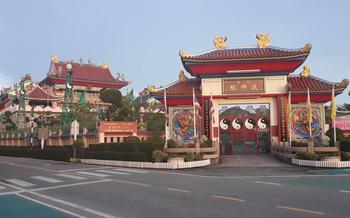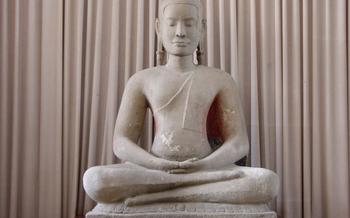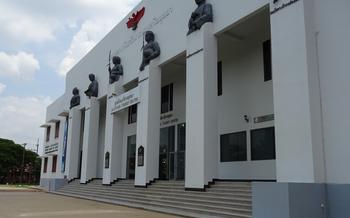
King Rama I Monument
- Historical Significance
- Location and Accessibility
- Architectural Features
- Surrounding Area
- Historical Context
- Visitor Experience
- Guided Tours
- Photography Tips
- Local Customs and Etiquette
- Nearby Attractions
- Souvenirs and Shopping
- Food and Dining Options
- Accommodation Options
- Safety Tips
- Insider Tip
- Unveiling the Hidden Gem of Prasat Hin Phanom Rung
Historical Significance
The King Rama I Monument stands as a testament to the remarkable life and achievements of King Rama I, the founder of the Chakri Dynasty and the first king of modern Thailand. Erected in 1967, the monument commemorates his visionary leadership, military prowess, and profound contributions to the nation's history. King Rama I, also known as Phra Buddha Yodfa Chulaloke, ascended to the throne in 1782 and played a pivotal role in uniting the warring kingdoms of Siam, laying the foundation for a unified and prosperous Thailand. His reign marked a period of stability, cultural revival, and territorial expansion, earning him the title "Father of Modern Siam." The monument serves as a symbol of his legacy, paying homage to his wisdom, courage, and unwavering dedication to the country he shaped.
Location and Accessibility
The King Rama I Monument stands tall and proud in the heart of Buriram, a vibrant province in northeastern Thailand. It is strategically located within the city's bustling downtown area, making it easily accessible for both domestic and international visitors. The monument is situated within the lush greenery of a public park, offering a tranquil oasis amidst the urban landscape. To reach the site, visitors can conveniently take a tuk-tuk or songthaew, the local public transportation options, from anywhere in the city. Alternatively, renting a bicycle or motorbike is an excellent way to explore the city and its attractions at your own pace.
Architectural Features
The King Rama I Monument stands as a testament to the grandeur and artistry of the Rattanakosin era. Its architectural style is a blend of traditional Thai and European influences, showcasing intricate details and symbolic elements. The monument features a towering central spire, adorned with elaborate carvings and colorful tiles, which represents the pinnacle of power and authority. At the base of the spire, four smaller spires surround it, each representing a cardinal direction and symbolizing the king's reach and influence over the entire kingdom.
The monument's facade is adorned with intricate bas-reliefs depicting scenes from Thai mythology, history, and the life of King Rama I. These carvings showcase the skill and artistry of Thai craftsmen, narrating stories of battles, royal ceremonies, and the king's achievements. Inscriptions in Thai and Pali scripts adorn the monument, paying homage to King Rama I's virtues, his reign, and his contributions to the nation.
The symbolism embedded in the monument's design is profound. The central spire, with its gradual ascent, represents the king's rise to power and his ultimate achievement of the throne. The four smaller spires surrounding it symbolize the four regions of Thailand, unified under his rule. The bas-reliefs serve as visual representations of the king's accomplishments, his commitment to tradition, and his role as a guardian of the nation's heritage.
Surrounding Area
The King Rama I Monument is situated within a beautifully landscaped park, offering visitors a tranquil oasis to relax and appreciate the natural surroundings. The park features lush gardens with colorful flowers, towering trees providing shade, and well-maintained pathways for leisurely strolls. Visitors can take a break from sightseeing and enjoy a picnic in the designated areas, surrounded by the serene ambiance of the park. Additionally, the park offers panoramic viewpoints that provide breathtaking views of the city and the surrounding countryside, making it an ideal spot for photography enthusiasts. The combination of historical significance and natural beauty makes the King Rama I Monument and its surrounding park a must-visit destination for anyone exploring Buriram.
Historical Context
King Rama I, also known as Phra Buddha Yodfa Chulaloke, reigned over Siam, now Thailand, from 1782 until his death in 180His reign marked a significant turning point in Thai history, as he established the Chakri Dynasty, which continues to rule Thailand today.
King Rama I's reign was characterized by both challenges and achievements. He faced numerous threats to his kingdom, including invasions from neighboring Burma and Vietnam. However, he successfully repelled these invasions and secured Siam's independence.
In addition, King Rama I initiated a series of important reforms that helped to modernize and strengthen the kingdom. He established a new capital city, Bangkok, which replaced the former capital of Ayutthaya, which had been destroyed by the Burmese. He also reformed the administrative system, the military, and the legal system.
King Rama I's contributions to Siam were immense. He is remembered as a wise and capable ruler who laid the foundation for the modern Thai state. His legacy continues to inspire and motivate the Thai people to this day.
Visitor Experience
My visit to the King Rama I Monument was an awe-inspiring experience that transported me back in time. As I stood before this majestic tribute to the founder of the Chakri Dynasty, I felt a profound sense of reverence and admiration. The meticulously crafted sculptures and bas-reliefs seemed to come alive, narrating the glorious history of Thailand and the remarkable achievements of King Rama I.
The monument's serene surroundings added to the contemplative atmosphere. The lush gardens and tranquil walkways invited me to pause and reflect on the king's legacy. I couldn't help but marvel at his vision, determination, and unwavering commitment to the prosperity and unity of Thailand.
More than just a historical landmark, the King Rama I Monument is a testament to the enduring spirit of the Thai people. It serves as a reminder of the deep-rooted values and traditions that have shaped the nation's identity. As I left the monument, I carried with me a renewed appreciation for Thailand's rich history and a profound respect for the visionary king who laid the foundation for its modern success.
Guided Tours
For a more immersive and informative experience, visitors can opt for a guided tour of the King Rama I Monument. These tours are led by knowledgeable guides who provide in-depth insights into the monument's history, significance, and architectural features. Visitors will learn about King Rama I's reign, his achievements, and the cultural and historical context of the monument's creation. Guided tours typically last for about an hour and are available in various languages. Prices range from 100 to 200 baht per person, depending on the group size and duration of the tour. To book a guided tour, visitors can inquire at the tourist information center or contact local tour operators.
-
Benefits of Taking a Guided Tour:
-
Gain in-depth knowledge and historical insights from expert guides.
- Learn about the monument's significance, symbolism, and cultural context.
- Ask questions and engage in discussions about King Rama I and his reign.
- Enhance your understanding and appreciation of the monument's beauty and grandeur.
-
Get personalized recommendations for other attractions and activities in Buriram.
-
Booking Information:
-
Guided tours can be booked in advance or upon arrival at the monument.
- Contact local tour operators or inquire at the tourist information center for availability and pricing.
- Book early to secure a spot, especially during peak tourist season.
- Group discounts may be available for larger groups.
Photography Tips
Capturing the beauty of the King Rama I Monument through photography is a rewarding experience. Here are some tips to help you take stunning photographs:
-
Choose the Right Angle: The monument's grandeur is best captured from a low angle, allowing you to emphasize its towering height. Experiment with different angles to find the perfect perspective.
-
Consider Lighting: The best time to photograph the monument is during the golden hours of sunrise or sunset when the warm light enhances its intricate details. Avoid harsh midday sun, which can create unwanted shadows.
-
Adjust Camera Settings: Use a wide-angle lens to capture the entire monument in a single frame. Set your camera to a low ISO to minimize noise and ensure sharp images. Use a tripod for stability, especially in low-light conditions.
-
Play with Composition: Incorporate elements of the surrounding environment, such as trees, flowers, or people, to add depth and interest to your shots. Experiment with different compositions to create unique and captivating images.
-
Capture the Details: Take close-up shots of the monument's intricate carvings, sculptures, and inscriptions to showcase the craftsmanship and artistry involved in its creation. These details add depth and a sense of history to your photographs.
Local Customs and Etiquette
When visiting the King Rama I Monument, it is essential to be mindful of local customs and etiquette to show respect for Thai culture. Visitors should dress appropriately, avoiding shorts, tank tops, or revealing clothing. It is customary to remove your shoes before entering certain areas of the monument, such as the inner sanctum or prayer hall. When in doubt, observe the behavior of other visitors or ask a local guide for guidance. Remember to maintain a respectful demeanor and avoid loud noises or disruptive behavior. Photography is generally allowed, but it is important to refrain from taking photos of monks or other religious figures without their permission. By respecting local customs and etiquette, you can contribute to a positive and harmonious experience for everyone.
Nearby Attractions
The King Rama I Monument is surrounded by several other attractions that visitors can explore. Nearby landmarks include the Buriram United Stadium, home to the famous Thai football club, and the Chang International Circuit, a renowned motorsports venue. For those interested in history and culture, the Buriram National Museum offers insights into the region's past, while the Prasat Hin Phanom Rung, an ancient Khmer temple complex, is a UNESCO World Heritage Site and a must-see for history enthusiasts.
For a unique experience, visitors can explore the vibrant local markets, such as the Buriram Night Market, where they can browse local handicrafts, sample delicious street food, and interact with friendly vendors. For those seeking natural beauty, the Khao Kradong Forest Park, with its lush forests and stunning views, is just a short drive away. By combining a visit to the King Rama I Monument with these nearby attractions, visitors can create a comprehensive and memorable travel experience in Buriram.
Souvenirs and Shopping
The King Rama I Monument area offers a variety of souvenir shops and local markets where visitors can purchase unique mementos of their visit. From traditional Thai handicrafts and local products to commemorative souvenirs, there's something for every taste and budget.
One popular souvenir is the mini replica of the King Rama I Monument itself, a perfect way to remember the grandeur and historical significance of the site. Visitors can also find a range of traditional Thai handicrafts, such as woven baskets, ceramic pottery, and intricate wood carvings, all showcasing the skill and artistry of local craftspeople.
For those looking for something more unique, the local markets offer a treasure trove of hidden gems. Visitors can haggle for colorful textiles, handmade jewelry, and aromatic spices, experiencing the vibrant atmosphere of Thai markets firsthand.
Whether you're looking for a meaningful keepsake or a gift for loved ones back home, the King Rama I Monument area has something special to offer. Embrace the opportunity to support local artisans and take home a piece of Buriram's rich cultural heritage.
Food and Dining Options
Indulge in Authentic Thai Cuisine and Local Delights
After exploring the grandeur of the King Rama I Monument, take a culinary journey into the heart of Thai cuisine. Buriram offers a diverse range of dining options, from street food stalls to upscale restaurants, catering to every taste and budget.
For an authentic Thai experience, venture into the local markets, where you'll find an array of street food vendors serving up traditional dishes such as pad thai, som tum, and khao soi. These vibrant markets offer a glimpse into the local way of life, where you can interact with friendly vendors and savor the flavors of Thailand's beloved street food.
If you prefer a more refined dining experience, Buriram also boasts several excellent restaurants serving traditional Thai cuisine and international fare. Sample the region's specialties, including the spicy nam prik kapi and the aromatic larb buriram, a minced meat salad with herbs and spices.
For those seeking international cuisine, Buriram offers a variety of options, from Italian trattorias to Japanese sushi bars. Whether you're craving a hearty steak, a wood-fired pizza, or a delicate sushi platter, you'll find something to satisfy your taste buds.
No matter your preference, Buriram's culinary scene promises a delightful experience. Embrace the opportunity to savor the flavors of Thailand and indulge in a feast for your senses.
Accommodation Options
For a convenient and comfortable stay, visitors can choose from a variety of accommodation options near the King Rama I Monument. Budget-minded travelers can find affordable guesthouses and hostels within walking distance of the site. These offer basic amenities and shared facilities, making them a great choice for backpackers and solo travelers. For those seeking a more upscale experience, several mid-range hotels and resorts are located nearby, offering a range of amenities such as swimming pools, fitness centers, and restaurants. For a truly luxurious stay, visitors can opt for one of the high-end resorts in the area, which provide exclusive amenities, personalized services, and breathtaking views. To ensure a hassle-free visit, it's advisable to book accommodations in advance, especially during peak tourist season or major events in Buriram.
Safety Tips
Visiting the King Rama I Monument and its surroundings is generally safe, but as with any tourist destination, it's important to take precautions to ensure a smooth and enjoyable experience. Here are a few safety tips to keep in mind:
-
Be aware of your surroundings and keep an eye on your belongings, especially in crowded areas.
-
Avoid carrying large amounts of cash and valuables, and keep your wallet or purse close to you.
-
Be wary of pickpockets and scammers who may try to distract you or take advantage of your trust.
-
If you're exploring the area on foot, stay on well-lit paths and avoid isolated areas, especially at night.
-
Be respectful of local customs and traditions, and dress appropriately when visiting temples or religious sites.
-
Follow the instructions and guidelines provided by the monument's staff or tour guides.
-
In case of an emergency, dial the national emergency number 191 for police assistance or 1669 for medical help.
By following these simple safety tips and exercising common sense, you can ensure a safe and enjoyable visit to the King Rama I Monument and the surrounding area.
Insider Tip
Unveiling the Hidden Gem of Prasat Hin Phanom Rung
For an unforgettable experience, venture beyond the King Rama I Monument and discover the nearby Prasat Hin Phanom Rung, an ancient Khmer temple nestled atop an extinct volcano. This hidden gem, often overlooked by tourists, boasts breathtaking views of the surrounding countryside and intricate carvings that rival those of Angkor Wat. Ascend the steep staircase to the temple's sanctuary and marvel at the iconic lintel depicting the churning of the ocean of milk, a Hindu mythological scene. Explore the temple's galleries, courtyards, and towers, each adorned with exquisite bas-reliefs and sculptures that narrate tales from Hindu mythology. Immerse yourself in the serenity of this sacred site and capture stunning panoramic shots from the temple's elevated vantage point. Prasat Hin Phanom Rung is a true hidden gem that offers a glimpse into Thailand's rich cultural heritage and architectural wonders.



